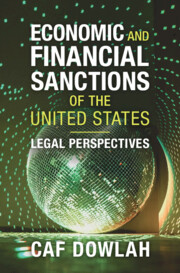Book contents
- Economic and Financial Sanctions of the United States
- Economic and Financial Sanctions of the United States
- Copyright page
- Dedication
- Contents
- Figures
- Tables
- Preface
- Table of Cases
- Table of Statutes and Regulations
- Conventions, Treaties, and Resolutions
- Presidential Executive Orders
- Abbreviations
- 1 Overview of Economic and Financial Sanctions
- 2 Economic and Financial Sanctions under International Law
- 3 Legal Frameworks of US Economic and Financial Sanctions
- 4 Enforcement Infrastructures of US Economic and Financial Sanctions
- 5 US Economic and Financial Sanctions against the Russian Federation
- 6 US Economic and Financial Sanctions against the Islamic Republic of Iran
- 7 US and Multilateral Sanctions Regimes against the Republic of Iraq
- 8 US Economic and Financial Sanctions against the Republic of Cuba
- 9 US Economic and Financial Sanctions against the Bolivarian Republic of Venezuela
- Index
- References
2 - Economic and Financial Sanctions under International Law
Published online by Cambridge University Press: 22 March 2025
- Economic and Financial Sanctions of the United States
- Economic and Financial Sanctions of the United States
- Copyright page
- Dedication
- Contents
- Figures
- Tables
- Preface
- Table of Cases
- Table of Statutes and Regulations
- Conventions, Treaties, and Resolutions
- Presidential Executive Orders
- Abbreviations
- 1 Overview of Economic and Financial Sanctions
- 2 Economic and Financial Sanctions under International Law
- 3 Legal Frameworks of US Economic and Financial Sanctions
- 4 Enforcement Infrastructures of US Economic and Financial Sanctions
- 5 US Economic and Financial Sanctions against the Russian Federation
- 6 US Economic and Financial Sanctions against the Islamic Republic of Iran
- 7 US and Multilateral Sanctions Regimes against the Republic of Iraq
- 8 US Economic and Financial Sanctions against the Republic of Cuba
- 9 US Economic and Financial Sanctions against the Bolivarian Republic of Venezuela
- Index
- References
Summary
This chapter intricately examines the interplay between economic and financial sanctions and international law. It dissects multilateral and unilateral sanctions, outlining their legal parameters. Analyzing the delicate balance between these approaches, the chapter explores state sovereignty, non-intervention, countermeasures, and countersanctions. It navigates the complex realm of judicial proceedings within third-party countermeasures. Additionally, the chapter scrutinizes the connection between unilateral sanctions and the World Trade Organization framework, delves into the interaction of sanctions with human rights laws, and addresses how courts address the intricate juncture between sanctions and human rights within the broader international legal context.
Keywords
- Type
- Chapter
- Information
- Economic and Financial Sanctions of the United StatesLegal Perspectives, pp. 28 - 69Publisher: Cambridge University PressPrint publication year: 2025

